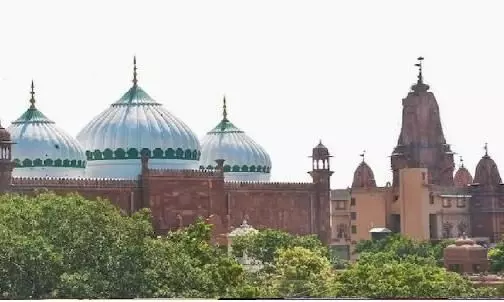
Plea in Mathura court to remove another Mughal-era mosque
text_fieldsMathura: In a fresh petition in a Mathura court demanded the demolishment of a Mughal-era mosque, Meena Masjid. The petitioner has claimed that the mosque was built on premises belonging to Thakur Keshav Dev Ji temple, at the eastern side of Sri Krishna Janmabhoomi complex, Uttar Pradesh, IANS reported.
The new case was filed by Dinesh Sharma of Akhil Bharat Hindu Mahasabha (ABHM), naming Thakur Keshav Dev Ji Maharaj (another name of Lord Krishna) as petitioner number 1. Sharma remained Vaad Mitra or friend of the suite in the case filed in the court of civil judge (senior division) Mathura, Jyoti Singh.
Earlier, Sharma had filed a case seeking the removal of the Shahi Masjid Idgah next to Sri Krishna Janmabhoomi. There are many petitions in various Mathura courts demanding the shifting of the Shahi Masjid Idgah from the complex. Petitioners argue that the location was the birthplace of Lord Krishna, and the mosque has been built within its core 13.37-acre premises.
"The basic purpose of the suit is to protect the property of Thakur Keshav Dev Ji Maharaj, who owns land measuring 13.37 acres in Mathura city on which Sri Krishna Janmabhoomi is located. We have now sought removal of the construction raised in the name of Meena Masjid near Vrindavan railway line at Deeg gate on land owned by the deity," Sharma's fresh plea stated.
It names the president/chairman of Uttar Pradesh Sunni Central Waqf Board, Lucknow, and the secretary, Intezamia Committee, Meena Masjid (Deeg Gate), Mathura, as respondents.
The court posted the hearing on the case for October 26.
There was a settlement between Shri Krishna Janmasthan Seva Sangh and Shahi Masjid Idgah, which was dated October 12, 1968. This was part of suit number 43 of 1967, and some of the cases that have been filed on Shri Krishna Janmabhoomi have challenged the settlement. According to petitioners, it has no legal validity since the Sri Krishna Janmabhoomi Trust, which owns the location, was not a party in the settlement.
They claimed that it was built in the same spot where a temple was razed by the Mughal emperor Aurangzeb.





